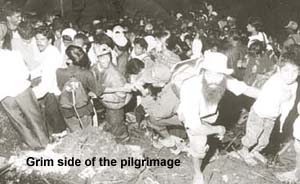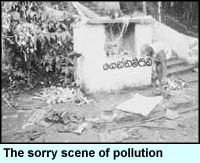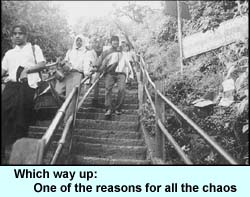 |
 28th February 1999 |
Front Page| |
Tomorrow is Medin Poya
It's 'Karunavai'all the wayBy D.C. RanatungaTomorrow, March 1is Medin Poya. It marks the peak of the Sri Pada pilgrim season. It's 'Karunavai' all the way. Karunavai! Karunavai! Saman Devindu Karunavai! Thus chant a group of youngsters climbing Sri Pada. The response comes from the 'nade' (group) coming down. Vandinta Yana Me Nadeta - Saman Devindu Karunavai! A young lad notices a pretty girl. Immediately he responds: Vandinta Yana Me Nangita - Sumana Saman Devi Pihitai! The young one blushes. Yet she replies - Vendala Bahina Me Aiyata - Sumana Saman Devi Pihitai! This is the mood and spirit of the Sri Pada pilgrims. Kindness, friendliness, comradeship. A youth would help an elderly person spontaneously. When one finds it difficult to walk, two or three would get together and carry him (or her). Everyone's desire is to reach the peak. The climb can be tough to some, pretty easy to others. The desire of every Buddhist is to climb Sri Pada at least once in his lifetime. 'Padme Karunakarala - Dolos Mahe Panata Thel Tikak Vakkaranna' is the ambition. The Pahana is an eternal flame - it lights throughout the twelve months. The first-time climber is advised to be extra careful. The Kodu Karaya (novice) must watch his step and guard his tongue. 'Kata Varaddaganna Epa' is the key advice given to him by the 'nade gura', the leader of the group. Some words are taboo. Devotees rarely talk about climbing Sri Pada. It's not `naginawa' but 'karunakaranava'. In the old days, never did one go to Sri Pada alone. It was always in a group. This was the age-old custom when the trip was hazardous. One is safe in a crowd. And there is always a seasoned pilgrim to guide the others, particularly the newcomers. From the time they get ready, they depend on 'Saman Deiyange Pihita' (assistance of God Saman) to worship the sacred footprint of the Buddha and get back safely. And many would go by train - the 'punchi kochchiya' on the Kelani Valley (KV) line. That takes the pilgrims up to Kuruwita. Then by foot to Palabaddala by nightfall. They spend the night there. Early morning after a dip in the Kalu Ganga, clad in white they start the climb. It takes at least a week for the trip. Things are different today. For most of them it's a pleasure trip. Yet many like to follow the age old traditions. Maintain a solemn mood. That's how it should be. As the 'Handbook for the Ceylon Traveller' (Studio Times) points out, there is probably no mountain more famous than Sri Pada - Adam's Peak, for non-mountainous reasons than this. "It is sacred to three religions at least; to Buddhists the human foot-shaped hollow on the pinnacle boulder marks one of the personal appearances of the Buddha; the Muslims believe that the depression marks Adam's expiation of his disobedience by standing there for an age, on one foot; to the Hindus, by whom the Peak has been venerated for millennia, its name is 'Sivan Adi (oli) Padham', for it is the Creative Dance of God Siva that the `print' calls to remembrance. It's Sri Lankan name - and sacredness- however, antedates even Buddhism. The name is 'Samanala Kanda' and Saman was a pre-Buddhist god, one of the four guardian deities of the Island. For this reason the clouds of yellow butterflies which annually appear and, to the eye of faith, seem to converge from every direction upon the holy mountain are called 'samanalayo.' To the Buddhists, Sri Pada is one of the sixteen places of veneration - 'Solosmasthana' - places hallowed by visits of the Buddha, according to chronicles. It is believed that the Buddha during his third visit to Sri Lanka placed his footprint on the summit of the sacred mountain. So the name Sri Pada - the sacred footprint. Its height is 7,362 feet (2,243 m) and it is the fifth highest mountain in the country after Pidurutalagala, Kirigalpota, Totapalakanda and Kudahagala. The Sri Pada pilgrim season is what is generally accepted as the calm bright months from January to April when devotees in their thousands make the trek to pay obeisance to the sacred footprint. There are at least three traditional routes to reach the peak. One is from Ratnapura (via Carney Estate) involving 10 miles on foot. The second, from Kuruvita (joining the first route for the last three miles,12 miles on foot. The third is from Hatton (via Maskeliya) about four miles on foot though nearly all of it are steps. The fabulous sight of the 'Ira Sevaya' - sunrise from the peak is something that most pilgrims don't want to miss. Many plan and time the start from bottom to reach the peak by dawn to witness this spectacle. But the timing can go wrong (as it happened to us on our last visit) depending on the crowds. With large crowds, movement is slow. One can get stuck for hours in one place. The 'Handbook' describes the sunrise thus: "The sunrise produces the famous spectacle of the Shadow of the Peak. The north-east winds that blow in the pilgrim season have laid some thousands of feet below it a layer of misty cloud. Over this the sun casts the vast dark triangular shadow of the huge summit pyramid. Its point lies, at first, upon the infinitely distant horizon, then, as the sun waxes, races backward, foreshortening the shadow, until it is swallowed altogether in the rock of the peak itself. A less advertised phenomenon (because it usually occurs outside the pilgrim season) is also occasionally to be seen: the even more fantastic spectacle of the so-called 'Spectre of the Brocken'. When the cloud layer happens to be vertically rather than horizontally piled the intruder on the summit terrace occasionally sees before him an enormously magnified image of all upon it - including himself - often encircled by a halo of rainbow hues". As sung by C T Fernando in one of his most popular numbers, Kalu, Mahaweli Kelanida Walawe - Sihilala Maha Ganga , the cool waters of four of Sri Lanka's main rivers begin from the holy peak. Devotees have climbed Sri Pada from time immemorial. They will continue year after year. The cries of Karunavai, Karunavai will continue to reverberate the skies of Samanala Kanda for generations to come.
Pilgrims digressOnce a holy pilgrimage for the faithful seems to have become a holiday trip now, reports Udena R. AttygalleSomething fluttered close to my face. A butterfly I thought. But I was wrong-it was one of those constant reminders of modern humanity, a polythene bag. It slowly fell away to join its many counterparts on the path to the top of this holiest of mountains . Sri Pada, Sivanoli Patha Malai, Adam's Peak, Al Rohun or whatever name you call it, is a mountain blessed with incredible beauty and even greater faith. But all is not well, faith seems to be taking a back seat reserved for a few believers. On the night of February 20 we found the majority climbing to the top seemed to have fun and frolic central in their minds. The disorder, drunkenness and unhygienic conditions along the way were as difficult to bear as the biting cold at the peak. On this night and in the early hours of February 14 the crowds were phenomenal. The Maskeliya police estimated that around 300,000 people had arrived that night. The line of vans parked stretched up to 8 kilometres from Dalhousie. As we trekked up the mountain along with this seemingly endless stream of humanity our lungs were filled with pure mountain air. But it was only momentary. Most of the way up we were choked by cigarette fumes. The crowd is checked and any bottles of liquor found are destroyed by the Army at the Moussakelle checkpoint. But smuggling of liquor is not a problem, as SP Ananda Stephen in charge of the Dalhousie police said. Even some of the stalls on the way sell liquor on the sly. According to him the stalls on the middle stretch along the path are handled by an estate. Stalls at the top are under the purview of the Ambagamuwa pradeshiya sabha.
According to SP Stephen, the drunken behaviour of the crowds is a major cause of concern. Though it is usually rowdyism like insulting people and bothering women it sometimes erupts into fisticuffs and knife jabbing. About a quarter of the way to the top the queue stopped. There was no more room on the steps. The mass of people trying to go up was making it very difficult for those descending. We waited for half an hour and yet we hadn't moved an inch. So we followed the example of an adventurous few. We left the stairway and started trekking up the forest pathway alongside the steps. The pathway had been created only the other week, when "devotees" on that day too had left the steps. They in their endeavour to get to the top had created this pathway. The pathway being unlit, we could hardly see what our feet touched. Moreover the rains had made the ground soggy. Groping and falling we pushed on. It was wonderful to see that here at least people were helping each other. Whenever we fell there was always a helping hand to get us up. But it was both amazing and disconcerting to see mothers with babies and old ladies too, taking to this perilous path. Those trickling in from the top advised us to get back to the steps , the police they said were baton charging people going along this path. But nobody seemed to care. If we were to rejoin the queue we would have to go back all the way to Dalhousie. Then things started happening. We were suddenly met by people at the top trying desperately to get down. Absolute pandemonium prevailed. A small stampede had started. The police it seemed were taking action. Desperately we climbed to the spot where the incident was taking place. It was not the police, it was only a shop owner trying to protect his stall from getting overrun! Jagath Dissanayke, owner of the stall near the Galpotta area had an interesting tale to tell. He showed us a thick power cable severed by the crowd. One wrong step and electrocution, blackouts at the top were all possible, he said. The power line had run along the forest but the rush of the crowd had dragged it dangerously close to the steps.
According to Jagath he had decided to take action because the "police are asleep". The Indikatupahana police post is a couple of hundred yards below with five personnel. They said that controlling the crowd had become difficult because of the lack of regard for others among the devotees. The Maskeliya consumer service centre of the Ceylon Electricity Board said that on the 14th the CEB depot at Gangula had repaired the cable as fast as possible. The power cables had been put along the forest except for this one place where it comes close to the steps. The path created by the devotees had crossed the cable line. To avoid a total blackout there are fuses at regular distances with the transformers being at Dalhousie, Indikatupahana and Sithagangula. A cup (gulp?) of plain coffee at this stage costs Rs 20. Further up the price doubles.! A small roti costs Rs 10! Is this fair when considering the transportation difficulty or is this plain robbery.? A few yards above we found a railing dividing the steps. A huge board said climb from the right. And here were all these people climbing from the left . The people coming down were on the same side! One of the reasons for all this chaos had been discovered. With police posts from the Nuwara Eliya district at Dalhousie, Gangula ,and Indikatupahana, and with Ratnapura district post at the peak could there be more crowd control? Or is it just that the "devotees" no longer have any devotion?
Though the sunrise it-self was not clear the scene it created was mesmerizing . In a spellbinding moment the dark veil was lifted revealing an emerald carpet all around us, pierced only by mountains as beautiful as the forests that cover them. The cold and tiredness were all forgotten as we watched the sunrays touch the waters of the reservoir some thousand feet below. On the way down we were saddened to see that the path was littered with plastic refuse. The smell along some paths was unbearable. With only one public toilet midway on the climb, who could blame the pilgrims. It seems that the sunrise not only revealed the beauty but also the ugly side of the pilgrimage. Incidentally the railing on the left side on the bridge over the 'Seetha Gangula' river was also shaky. A massive crowd like on the 14th could easily cause it to collapse. Kumara Malgammana, who is in charge of the Saukyadana first-aid stations said they get over a thousand people coming for medical attention each day. Many complain of severe headache. Not surprising, said Kumara, when they bathe in the freezing waters of the Seetha Gangula after exerting themselves so much. As SP Stephen said the crowds on the 14th were due to a large number of couples coming on Valentine's Day. So the unyielding tentacles of commercialization have reached this holy ground as well. The climb to the top is a mixed bag but if you are a "Kodu karaya" (novice) it will still be an unforgettable one. |
||
 |
More Plus * They spread the message of nature
Front Page| News/Comment| Editorial/Opinion| Business| Sports | Mirror Magazine |
|
 |
Please send your comments and suggestions on this web site to |
|
 These
stalls are seasonal. They are dismantled when the season ends. The forest,
meanwhile, silently suffers, as trees are chopped down illicitly about
a month before the season begins. The next season it happens again.
These
stalls are seasonal. They are dismantled when the season ends. The forest,
meanwhile, silently suffers, as trees are chopped down illicitly about
a month before the season begins. The next season it happens again. On
February 14, Jagath had only awakened to the danger when the power went
out. More than 50 people were by then already under the stall. One broken
wedge and it would have spelled disaster for all. A man passing under a
transformer too had been electrocuted at Idikatupahana on this path.
On
February 14, Jagath had only awakened to the danger when the power went
out. More than 50 people were by then already under the stall. One broken
wedge and it would have spelled disaster for all. A man passing under a
transformer too had been electrocuted at Idikatupahana on this path. At
the top of the peak it is simply freezing. As we offered our prayers and
waited for the sunrise, a loud speaker blared asking pilgrims to keep a
constant watch on valuables. Does this imply that robbery goes on in the
vicinity of the sacred foot- print?
At
the top of the peak it is simply freezing. As we offered our prayers and
waited for the sunrise, a loud speaker blared asking pilgrims to keep a
constant watch on valuables. Does this imply that robbery goes on in the
vicinity of the sacred foot- print?